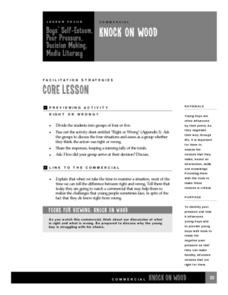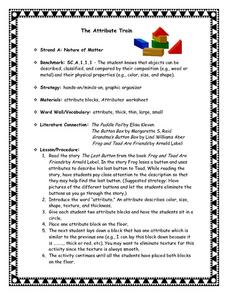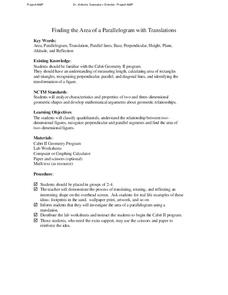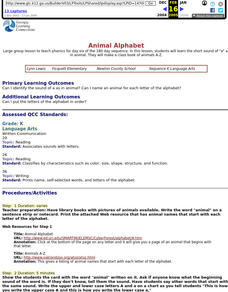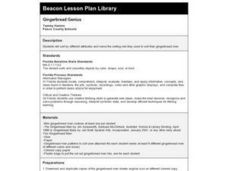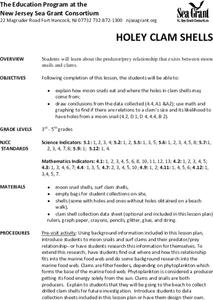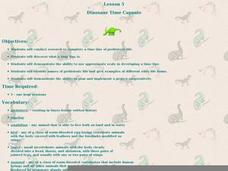Curated OER
Translations, Reflections, and Rotations
Students are introduced to the concepts of translation, reflection, and rotation. They practice translating, reflecting, and rotating two-dimensional objects on the coordinate plane. students use computers to learn about the three concepts.
Curated OER
Knock On Wood
Learners investigate the trees of the Mississippi Valley, specifically looking at the coniferous and deciduous forests. The research of the area is part of a field study when students conduct a survey of local forests in order to create...
Curated OER
The Attribute Train
Students participate in a hands-on activity working with attribute blocks. After reading a story about attributes as a class, they each are given two attribute blocks. The first student lays one attribute block on the floor with the next...
Curated OER
Paramecium
In this paramecium worksheet, students sharpen their science skills as they color the parts of a paramecium according to the instructions and then respond to 15 analysis questions.
Curated OER
Solids, Liquids, and Gases
Students explore solids, liquids, and gasses and categorize and describe the three states of matter. In this chemistry lesson, students categorize items as solid, liquid, or gas based on the definitions given by the teacher. Students...
Curated OER
Three States of Matter
Students explore the three states of matter. In this matter lesson, students are shown a variety of examples and decide whether it is a liquid, solid or gas. Students brainstorm what characteristics the objects in each group share.
Curated OER
Making Changes
Students observe and record the changes they see when adding heat and cold to objects. For this changes lesson plan, students experiment with different objects and see if heat and cold change the makeup of the object. They then record...
Curated OER
Finding the Area of a Parallelogram with Translations
Learners calculate the area of a parallelogram. In this geometry lesson, students perform translation using a coordinate plane and coordinate pairs. They perform translation on other polygons.
Curated OER
Finding the Area of a Parallelogram with Translations
Students calculate the area of parallelograms. In this geometry lesson, students identify properties of parallelograms and use to to solve problems. They create polygons using Cabri software.
Curated OER
Shells
Sixth graders label diagrams of the 6 different classes of mollusks and explain the meaning of the labeled terms. They identify 8 common New Haven shells. They organize their own shell collection during this series of lessons.
Curated OER
Animal Alphabet
Students make a class animal book using the letters of the alphabet. They use a website imbedded in this plan to get pages with animals that begin with any of the 26 letters.
Curated OER
Revolutionary Tea Parties and the Reasons for Revolution
Eleventh graders list some tea party protests other than the Boston Tea Party, then state some possible reasons behind the tea protests. They explain the connection between the Boston Tea Party, other tea parties, and events that...
Curated OER
Trekking to Timbuktu: Timbuktu: A Center of Trade - Teacher Version
Fourth graders discuss the origins of Timbuktu, explain the importance of its location, and describe the kingdom of Mali. They also explain how and why Timbuktu became a part of Mali.
Curated OER
As a Matter of Fact
Students rotate through various hands-on experiment stations to explore the concept and properties of different types of matter. They compare some properties of solids, liquids and gases and describe how matter changes from one state to...
Curated OER
On the Road with Marco Polo: From Venice to Hormuz
Students take virtual trip with Marco Polo from Venice to China. They explore terrain of Iran.
Curated OER
Couriers in the Inca Empire: Getting Your Message Across
Learners explore how the Inca communicated across the bast stretches of their mountain realm.
Curated OER
Gingerbread Genius
Students sort gingerbread men, then identify the sorting rule that they used.
Curated OER
It Figures!
Students judge, compare and construct two-dimensional figures using a variety of materials.
Curated OER
Neat Feet
Pupils view a video and discuss different kinds of feet found in the animal kingdom. They make prints using paint, rubber stamps and their own feet and then measure and compare the tracks.
Curated OER
Holey Clamshells
Learners analyze data to make hypotheses and conclusions regarding the predator/prey relationship between moon snail and surf clams.
Curated OER
Mathematics: Prime and Composite Numbers
Sixth graders explore how to apply the commutative property and the rules of divisibility. They examine the difference between prime and composite numbers.
Curated OER
How to identify a physical change from a chemical change
Students identify the difference between some physical and chemical properties and compare some physical and chemical changes. They design an experiment to distinguish between a physical or a chemical property of their choice.
Curated OER
Exploring Function Graphs
Tenth graders investigate three different sets of data that relate temperature to another variable in the physical world. These illustrate linear, inverse and exponential relationships.
Curated OER
Dinosaur Time Capsule
Third graders research prehistoric life using educational software. They design a prehistoric life while showing the use of appropriate scale and names for the prehistoric life. They follow an internet link to participate in a virtual...



